Bronco 1/35 Fi-103A-1
|
KIT #: |
5040 |
|
PRICE: |
$34.98 |
|
DECALS: |
One Option |
|
REVIEWER: |
Tom
Cleaver |
|
NOTES: |
|
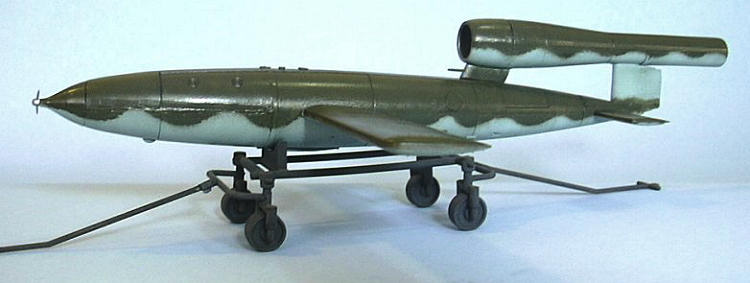
The Fieseler Fi-103 was the world’s
first mass-produced cruise missile to be used operationally.
While allied propaganda during the war downplayed the
effect of this weapon, it is useful to consider that General Clayton Bissell
wrote a report to Hap Arnold in December 1944, in which he stated that - based
on the experience the Allies had had in combating the weapon - it was his belief
that this truly was the weapon of the future, one that would make the manned
strategic bomber obsolete.
He buttressed his argument with several pages of
statistics regarding the cost of the airframe versus that of a manned bomber,
its overall effectiveness (“bang for the buck”) and effect on the enemy in
forcing him (in this case the Allies) to mount a defense that cost far more than
the entire cost of developing and using the weapon.
Later historians have also pointed out that, had the
Germans been able to make full use of the “ski sites” in the Pas de Calais
(which were very resistant to bombing) and managed to launch their attack with
this weapon in the Spring of 1944 before the Normandy invasion, it might well
have delayed the invasion.
As it was, the only real defense was overrunning the
launch sites on the continent following the invasion.
The war might well have lasted into 1946 and beyond had
the Fi-103 entered combat in March, rather than June.
The Fieseler Fi-103 is better known
to history as the V-1 (German: Vergeltungswaffe 1, or “revenge weapon number
one”) The Fi-103 was designed by Robert Lusser of the Fieseler company and Fritz
Gosslau of the Argus engine works.
It was as simple as could be created, with a fuselage of
welded sheet steel and wings built either from steel or plywood. The very simple
pulse jet engine pulsed 50 times per second, and the buzzing sound thus created
gave rise to the colloquial names "buzz bomb" or "doodlebug" (so named for an
Australian insect).
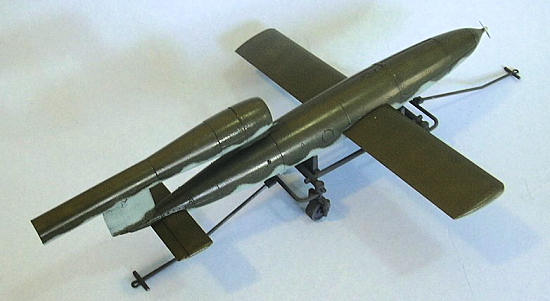 Between June 17, 1944 and
March 29, 1945, it was fired at population centers such as London and Antwerp.
V-1s were launched from "ski" launch sites along the French (Pas-de-Calais) and
Dutch coasts until the sites were overrun by llied forces. The underground V-1
storage depots at Saint-Leu-d'Esserent, Nucourt and Rilly-la-Montagne, as well
as the launch sites, were bombed during Operation Crossbow.
Between June 17, 1944 and
March 29, 1945, it was fired at population centers such as London and Antwerp.
V-1s were launched from "ski" launch sites along the French (Pas-de-Calais) and
Dutch coasts until the sites were overrun by llied forces. The underground V-1
storage depots at Saint-Leu-d'Esserent, Nucourt and Rilly-la-Montagne, as well
as the launch sites, were bombed during Operation Crossbow.
The guidance system of the Fi-103
used an autopilot to regulate height and speed. A weighted pendulum system
provided pitch control, which was damped by a gyrocompass, which was set by
swinging before launch; this was angled away from the horizontal so that the
gyroscope stayed trued up by feedback from the magnetic field , and from the
fore and aft pendulum. All this interaction meant that rudder control was enough
without a separate banking mechanism.
This was also the secret to the best way to defeat the
weapon, by “tipping” it in flight, which toppled the gyrocompass and sent it out
of control.
A countdown timer driven by a vane
anemometer on the nose determined when the target range had been reached, which
was accurate enough for area bombing. The counter was set before launch to a
number that would reach zero over the target in the prevailing wind conditions.
The airflow turned the propeller, with every 30 rotations counting down one
number on the counter. When the count reached zero, two detonating bolts were
fired. Two spoilers on the elevator were released, while the linkage between the
elevator and servo was jammed and a guillotine device cut off the control hoses
to the rudder servo, setting the rudder in neutral. This put the missile into a
steep dive, which stopped the fuel flow and stopped the engine. The sudden
silence alerted those on the ground to an impending impact.
This was later fixed so that later missiles impacted
under full power, which vastly increased their destructiveness.
Once the attacks began, The Germans
- who lacked adequate photo reconnaissance - relied on reports from their agents
in England to see if the range settings in the guidance system were correct.
Using the Double Cross system, British Intelligence gave the Germans false
reports of impacts northwest of the city center. The missiles were then
programmed for too short a run and fell well southeast of the city, which was
why Croydon suffered the greatest number of hits.
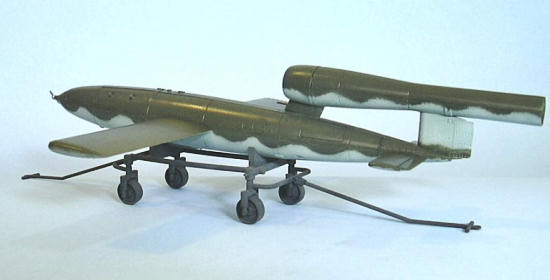 There is a myth that early guidance
problems were solved by a daring test flight by Hanna Reitsch in a V-1 modified
for manned operation, which has entered popular “history” from a fictional
depiction of this in the film “Operation Crossbow.”
There is a myth that early guidance
problems were solved by a daring test flight by Hanna Reitsch in a V-1 modified
for manned operation, which has entered popular “history” from a fictional
depiction of this in the film “Operation Crossbow.”
The earliest Fi-103s were
air-launched, but most were launched from land-based sites.
Between July 1944 to January 1945 the Luftwaffe launched
1,176 missiles from modified Heinkel He 111 H-22s of Kampfgeschwader 3 from
positions over the North Sea. The He-111s were vulnerable to night fighter
attack, since the launch lit up the area around the aircraft for several
seconds.
Almost 30,000 V-1s were made; of
these approximately 10,000 were fired at England, and 2,419 reached London,
killing 6,184 people and injuring 17,981.Antwerp was hit by 2,448 V-1s from
October 1944 to March 1945.
The Allies first became aware of
the existence of the Fi-103 in the summer of 1943, when one was photographed on
the launch rail at the Peenemünde test station in the Atlantic.
This was linked to the experimental V-83 pilotless
aircraft which had crashed on the Swedish island of Bornholm and to reports from
the Polish Home Army regarding construction of the weapon.
A Bomber Command raid mounted as a result of this may
have been the event that set back operational use of the Fi-103 so that it could
not intervene prior to the invasion.
By early 1944, “ski sites” - so
called because the concrete launchers resembled a ski - were detected under
construction in the Pas de Calais.
When the connection was made as to what the ultimate
purpose of these was, the 2nd
Tactical Air Force of the RAF and the 9th
Air Force of the USAAF were ordered to attack these sites, known to the aircrews
as “No Ball.”
Heavily defended by heavy, medium, and light flak, these rapidly
became the most dangerous targets in occupied Europe.
Dive bombing attacks by fighters were inconclusive, and
even massive raids by heavy bombers of both Bomber Command and 8th
Air Force were unsuccessful in knocking these out.
Allied pilots of the tactical air forces suffered their
highest casualties before the invasion attacking these sites to no final
outcome.
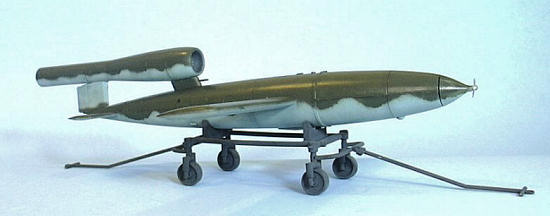 Once the missile attacks began, the
British defense consisted of anti-aircraft guns redeployed from positions on the
North Downs to the south coast of England, followed by a cordon closing the
Thames Estuary to attacks from the east. In September 1944, a new line was
formed on the coast of East Anglia, with a final deployment in December along
the Lincolnshire-Yorkshire coast. These were prompted by changes to the approach
tracks of the missiles as launch sites were overrun by the Allied ground advance
in northwestern Europe.
Once the missile attacks began, the
British defense consisted of anti-aircraft guns redeployed from positions on the
North Downs to the south coast of England, followed by a cordon closing the
Thames Estuary to attacks from the east. In September 1944, a new line was
formed on the coast of East Anglia, with a final deployment in December along
the Lincolnshire-Yorkshire coast. These were prompted by changes to the approach
tracks of the missiles as launch sites were overrun by the Allied ground advance
in northwestern Europe.
The gunners found the missiles a
fast-moving difficult target, since their cruising altitude of 2-3,000 feet was
just above the effective range of light anti-aircraft guns. This altitude and
speed were more than traverse rate of the British QF 3.7 inch mobile gun could
cope with, with the result that faster-traversing static gun emplacements had to
be built at great cost. In 1944, Bell Labs started delivery of an anti-aircraft
predictor fire-control system based around an analog computer, just in time to
be used in this campaign.
2,000 barrage balloons were
deployed, in the hope that the missiles would be destroyed when they struck the
tethering cables. The leading edges of the missile’s wings were equipped
with cable cutters, and fewer than 300 are known to have
been brought down by barrage balloons.
By far the most effective - and
expensive - defense was the deployment of high speed fighters to intercept and
shoot down the missiles.
This was dangerous, due to the fact the pursuing fighter
had to close to close range to hit the small target which was resistant to
machinegun fire due to being built of steel.
At this range, the missile could damage or destroy the
defender when it blew up on being hit.
Eventually, the pilots discovered the safest tactic was
to fly alongside the missile and “tip” it with their wingtip, throwing it out of
control to crash on the ground.
All of this was highly difficult, because the high speed
fighters were not all that fast at the lower altitude at which the missiles
flew.
The Royal Observer Corps was essential to these interceptions, and
proved far more capable than originallhy expected.
The Fi-103 lacked the vulnerability
of conventional aircraft: pilot, life-support, and a complex engine.
The Argus pulsejet provided sufficient thrust even if
damaged. The only one-shot stop points were the two bomb detonators and the line
from the fuel tank--three very small targets buried inside the fuselage.
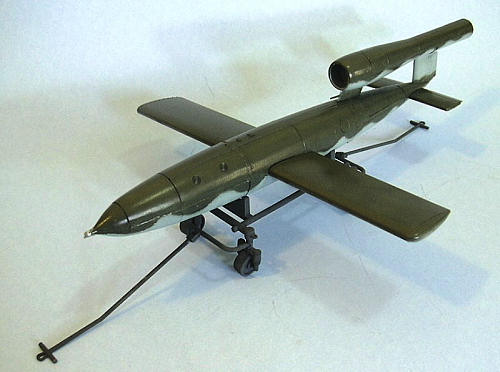 Eventually, all the Tempest
fighters in the RAF - the service’s best medium-altitude air-superiority
fighter, which was desperately needed in the air fighting over the western front
in Europe - were detailed to flying bomb defense.
They were not deployed to the Continent until late 1944,
after the missiles had been defeated by overrunning their launch sites on the
ground.
Eventually, all the Tempest
fighters in the RAF - the service’s best medium-altitude air-superiority
fighter, which was desperately needed in the air fighting over the western front
in Europe - were detailed to flying bomb defense.
They were not deployed to the Continent until late 1944,
after the missiles had been defeated by overrunning their launch sites on the
ground.
By September 1944, the threat to
England ended when all launch sites were overrun by the advancing Allied Armies.
4,261 V-1s had been destroyed by fighters, anti-aircraft fire and barrage
balloons.
The last incident on British soil occurred at Datchworth in
Hertfordshire on March 29, 1945, involving an air-launched missile.
As early as August, 1944, parts of
crashed Fi-103s were collected and sent to the United States, where they were
reverse engineered and production of the airframe was assigned to Republic and
the engine to Ford.
The first JB-2 was flight-tested in October 1944 at
Eglin Field, and the missile was placed into production for use in the coming
invasion of the Japanese home islands. Following the end of the war, the JB-2
was tested
at Wendover Field in Utah, which including comparison tests
between the original German missile and the American copy. In the late 1940s
preliminary design work was done on a small atomic warhead to be fitted to the
JB-2, but it was never built. The U.S. Navy - which had tested the missile in
submarine launches - briefly considered using the JB-2 during the Korean War
against North Korean targets.
While the Fi-103 did not have the
impact on the war that had been hoped, the Allies paid a price to defend against
it out of all proportion in terms of men and material diverted from the main
battle front on the continent compared to the cost of the entire system to the
Germans.
Today’s Tomahawk cruise missile is a direct descendant of the Fi-103.
This kit of the Fi-103A-1 from
Bronco is unexpected, at least to me, since I saw no earlier announcement.
Produced in 1/35 scale, it is “close enough” for a
modeler who does 1/32 to include it in their collection.
The kit comprises 37 parts in dark
grey plastic on three sprues, half of which go to the transport dolly.
Decals provide stenciling for one missile.
Overall, this is the most accurate
Fi-103 I have seen in any scale, when compared to drawings.
As with the missile itself, the kit is the essence of
simplicity.
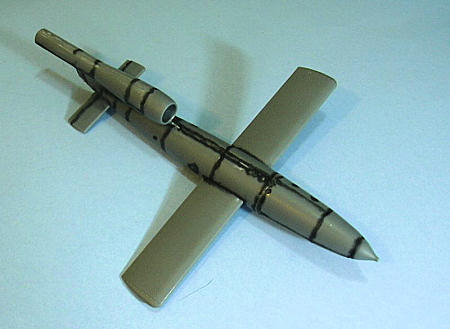 If you are careful and test fit,
you won’t use any filler on this model.
All parts breakdown is along panel lines, and the
resulting seams are so similar to the rest of the engraved detail that the model
eventually looks like it was one piece to begin with.
If you are careful and test fit,
you won’t use any filler on this model.
All parts breakdown is along panel lines, and the
resulting seams are so similar to the rest of the engraved detail that the model
eventually looks like it was one piece to begin with.
The two places where there is any
difficulty at all are getting the nose cap on tight and getting the intake of
the pulse jet on tight.
If you clean out the interior of the part around the
joint before attaching and then hold it in position until the glue sets up,
there should be no problem.
As I said, the kit is the essence
of simplicity, and took less than an hour to assemble.
I set it aside overnight for all the glue to harden.
The transport dolly took all of 20
minutes to assemble and was also set aside overnight.
(I'm obviously doing something wrong as it would take me that long just to
scrape and sand the mold seams! ;) Ed)
Painting:
I gave the model some pre-shading
with flat black along panel lines, then painted the lower surfaces with Tamiya
“Light Blue” which is RLM65 Hellblau,
and did the upper surfaces with Gunze-Sangyo RLM 71
Dunkelgrun.
This is one case where getting a nice neat demarcation line is
not necessary, since these missiles were given very rough paint jobs, from
available photos.
After allowing the paint to dry overnight, I put on the
few stencils and then gave the model a coat of Xtracrylix Flat Varnish.
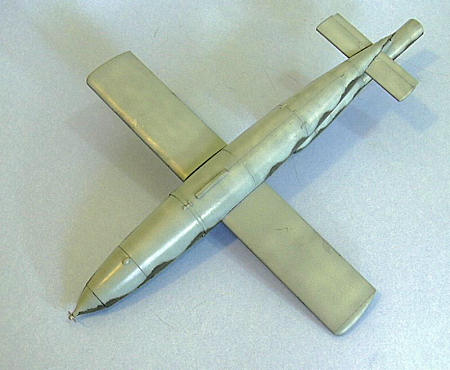 It’s not quite an “overnight
model,” but it’s close.
This would be a great kit to introduce a younger child
to modeling with (say age 8 up), since almost all the parts (other than the prop
on the nose) are large enough to handle easily, and breakage would be minimal.
It’s not quite an “overnight
model,” but it’s close.
This would be a great kit to introduce a younger child
to modeling with (say age 8 up), since almost all the parts (other than the prop
on the nose) are large enough to handle easily, and breakage would be minimal.
That said, this kit of the Fi-103
is definitely a “big boy’s toy.”
The missile is historically one of the most significant
aerial weapons of the 20th Century.
It didn’t stop the invasion, but it forced the Allies to
divert significant resources needed in that invasion to the defense of Great
Britain during the crucial months immediately following the invasion.
The United States gave it the immediate compliment of
reverse-engineering it and placing it in mass production, testament to just what
a potentially-powerful weapon it was.
Review kit courtesy of
Stevens International.
Tom
Cleaver
October 2008
If you would like your product reviewed fairly and quickly, please
contact
me or see other details in the
Note to
Contributors.
Back to the Main Page
Back to the Review
Index Page







